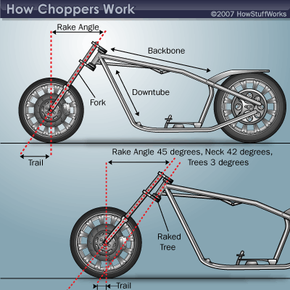Chopper Rake and Trail
Whether you're using a hard-tail or soft-tail, one of the most pivotal decisions you'll make regarding your bike has to do with the bike's rake and trail. You may have seen some choppers that look really stretched out, with the front wheel sitting far out in front of the bike's frame. Bikers can get this kind of look by adjusting the rake of the bike. The rake is the angle formed between the neck on the frame of a bike and a vertical line. The bigger the angle, the further out the front wheel will be from the frame.
The distance between the point where the tire makes contact with the ground and a vertical line from the center of the front wheel's steering axis to the ground is the bike's trail. Trail is measured in inches, and in motorcycles should always be a positive number -- a negative trail means an unstable ride. Trail is important -- too little or too much trail and the bike will be sluggish or even impossible to control. Bike experts all have different opinions on what's the ideal trail length, but it tends to range between 3.5 and 6 inches.
Advertisement
While there's a relationship between a bike's rake and its trail, it's not always obvious. In most cases, increasing the rake of a bike's frame will increase positive trail, though this depends on what kind of fork assembly you use. In order to increase the rake of a bike without making the trail too large, some bikers use raked trees. Trees mount the fork assembly to the neck of the frame and usually have two sets of mounting brackets of equal length. A raked tree's brackets are at two different lengths, allowing the builder to set his fork assembly at a different angle than that of the frame's neck to the vertical.
Once you've got your frame and rake set, it's time to start looking at what you're going to mount on this monster. The world of choppers is full of options, so no two bikes are going to be the same. Chopper builders need to consider how the various parts are going to fit together, whether they'll need to offset components and how it will affect the bike's performance and balance.
In the next section, we'll examine how the guts of a chopper fit together.
